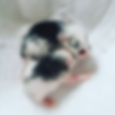
African Soft Fur (ASF)/
Natal multimammate
Most commonly referred to as ASF. They are an exotic rodent species that began as mostly a feeder animal but are gaining popularity as pets. They are not yet truly domesticated but can make lovely pets for the right owner. I got mine from a breeder who has been breeding them towards pet goals so that is very lucky! I am working on them as strictly pets and hoping to see a beautiful docile personality come out.
So what is an ASF?
An ASF is a Natal multimammate mouse (sometimes also called Natal multimammate rat). Though they are not actually quite mice or rats. They are rodents and in the same family as rats & mice Muridae, but are in the Genus Mastomys. Funny enough, they were first placed in the same Genus as rats, then changed to the same as mice before getting their own. Their species is Mastomys natalensis.
They go by so many different names, it can be confusing! But most commonly in the (at least US) pet/breeding community, we call them ASF.
As their name suggests they originated in Africa and because of that they do prefer a bit warmer temperatures. During the winter you want to make sure your home is kept warm, they have lots of bedding and houses to snuggle in and that the cage is placed in a warm location free of drafts or cold spots (which is true of any pet really).
The multimammate part of their name comes from the fact that they have 12 nipples on each side of their body, for a total of 24! Mice have 5 on each side for a total of 10 and rats 6 for a total of 12. ASFs are some nursing machines!
"Domesticated multimammate mice are much heavier on average, weighing from 60 to 130 grams. Males are larger and heavier than females. They weigh between 80 and 130 grams. Females are smaller and lighter build, normally weighting between 60 and 110 grams." - From Wikipedia .



Also as their name suggests they have soft fur. They are a little bigger than a mouse and have very very large eyes. Their eyes are the first thing that drew me to them as it gives them this very adorable sweet look!
Their lifespan is similar to rats and mice with 2-3 years on average.
ASF like most rodents are highly social and must be kept in good sized groups of three or more. They can be a bit fussy though and do not easily if at all accept new members into their established groups.
Is an ASF the right pet for me?
-
I do not feel this is a good pet for young children. Mature teens or adults are better suited.
-
Do you have a smaller home or space that is more suitable for a smaller pet and smaller cage?
-
Are you unable to let your rats out to play? Then a pet that is more cage bound is ideal.
-
Are you very busy and might not have the time to give daily hands-on attention to your pet, while still having enough time to clean and feed/care for it?
Cons:
They are not yet fully domesticated and may not be as easily handled
Housing
Tanks can be used for ASF as they do have less respiratory issues. At the very least 20 gallons but more is better. Still, tanks are not the ideal cage. They are heavy, hard to clean and can still easily have ammonia build up.
I feel ideally a properly made bin cage is the best cage for ASF. I prefer the 106/110qt bins or the huge Christmas Tree plastic storage bins! You can buy the 110 sterilite bin at target, and the 106 sterilite bin at walmart. The christmas tree ones you might have to wait for the holiday season sadly.
They need windows cut out and hardware cloth added (attached from the inside). You can NOT just poke air holes, that is not acceptable or safe.
Bedding I recommend the same as with rats- aspen or kiln dried pine.
There are a lot of really adorable toys and accessories for sale as you can use fun hamster things as well. They make adorable small houses, bridges, climbing things.
I think because of their less domesticated nature they can be more high energy. They definitely need lots of fun mental stimulation in their cages with lots to chew and I do suggest providing a wheel 8-12 inches with a solid floor-no mesh style or bar type wheels. But note some may chew the wheels. Never ever use a hamster style ball.
Diet
I do recommend the same diet as mice.
Obviously, they need a water bottle at all times with fresh clean water. Do not use a bowl, they will potty in it and get bedding in it or worse knock it over.
Prices
Pricing coming soon....
My Lines
I was able to work with a wonderful breeder to start my lines.
Niche Critters & Exotics, located in Indiana
I am not currently offering any for sale at this time.